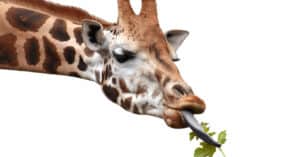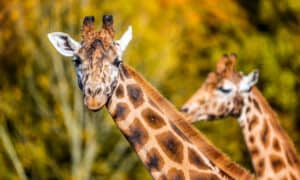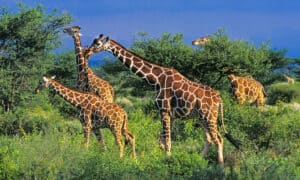If you’re asked what the tallest animal in the world is, you probably won’t think twice before saying it’s the giraffe. This extremely tall ruminant mammal towers at an average height of about 18 feet, making it the tallest land animal and one of the biggest animals on the planet. There are a lot of other interesting facts about the giraffe, from its extremely long neck, the nature of its hooves, and its unique spotted body. But, here’s one giraffe trivia you probably don’t have a quick answer to: What are those horn-like features on a giraffe’s head called, and what’s their purpose? Read on to find out the answer to this question and other interesting facts about the giraffe’s horns.
What Are Giraffe Horns Called?
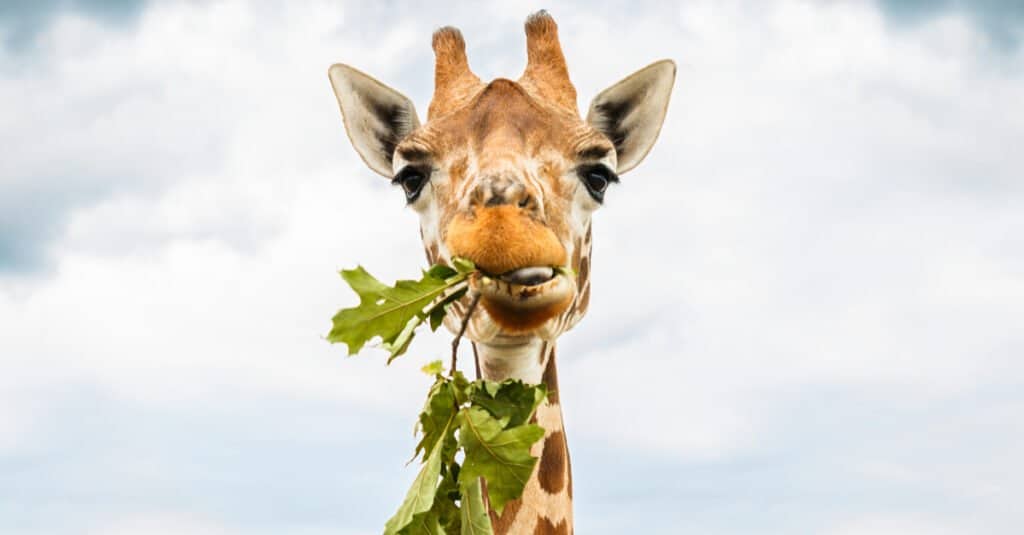
The horns on giraffes are called ossicones.
©Koverninska Olga/Shutterstock.com
The hairy, protruding features on a giraffe’s head don’t look like regular horns. They’re definitely not antlers, and it’ll be ridiculous to call them antennae. So what exactly are they?
The giraffe’s horns are known as ossicones. These ossicones are actually cartilages hardened into bone (ossified cartilage covered in the skin). Both female and male giraffes have ossicones. The ossicones are present right from birth, making them the only mammal to have horns from birth.
The giraffe’s horns/ossicones are a protrusion of its skull, and it differs in appearance and size from one giraffe species to the other. In females, the ossicones are relatively thin and hairy, but in male giraffes, the ossicones are thick, and the tops are bald due to fights between them.
Baby giraffes (calves) have ossicones but are not attached to the skull at birth. Instead, the horn lies flat on their heads like soft cartilage. This is important to avoid injury to the mother during birth.
As the baby giraffe grows, the horns grow too and will start fusing with their skulls. Giraffes typically reach sexual maturity between the ages of three and five years. By this time, the ossicone will fuse completely with the skull and is now mainly composed of bone. Some male giraffe species grow an extra pair of ossicones at the back of their skull, just behind the first pair. Some may also develop a middle ossicone on the forehead to bring the total number of horns to five.
The Purpose of Giraffe Horns
Giraffe ossicones don’t have the same intimidating appearance as a bull’s horns or a deer’s antlers. These other animals use their horns as weapons primarily in conflict among males within their species but also to defend against outsiders. Experts believe the giraffe’s ossicones might have served the same purpose at some point in their evolutionary past.
But what exactly do modern giraffes use their horns for? The truth is, experts are not exactly sure what the purpose of the giraffe’s horn is. Evolution suggests that ossicones were probably a big deal in prehistoric giraffe species. What we have today is merely a remnant of an appendage that was probably bigger and more useful to the giraffe’s ancient ancestors.
However, while it does not seem like a useful feature today, ossicones still have some minor purpose, especially for male giraffes. As diminutive as it is, the bony structure adds some weight to the giraffe’s head. Male giraffes need as much of this extra weight as they can get. Since they can’t lock antlers like deer or headbutt each other as mountain goats do, their only form of combat is swinging their long necks at each other. The pointy extrusion on their head adds extra weight to their head and a little more punch to each blow.
The fact that the ossicone is useful for combat is the main reason it looks different from males to females. Years of knocking their head against each other during the seasonal combat for mating rights gradually wear the fur and skin covering on the ossicones away, leaving the giraffe’s horn bald.
Identifying Species
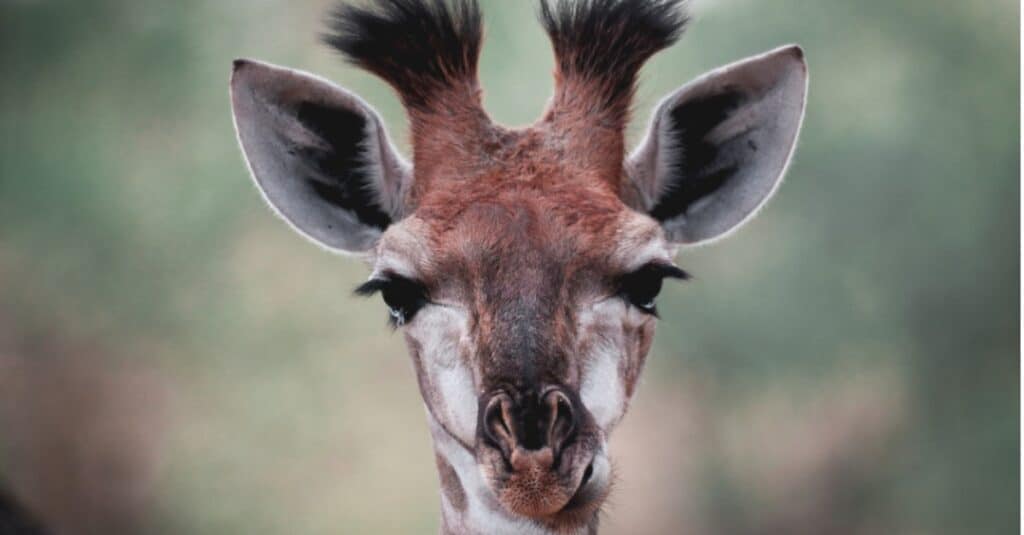
The nature of the ossicones can also help you tell different species apart.
©iStock.com/Annie DuPre-Reynolds
In addition to being weapons of war, the giraffe’s horns may also be useful to humans observing them too. This structure can help distinguish between species or even tell the sex of the animal. As earlier explained, The ossicones of male giraffes tend to be thicker and bald. Thus, if you see an adult giraffe with a thin ossicone with a tuft of hair growing out of it, you’re most likely looking at a female.
The nature of the ossicones can also help you tell different species apart. Some giraffe species grow additional ossicones on their heads. While these extra bumps are not as big as the others, they’re conspicuous too.
In fact, some species can grow up to five ossicones on their head. They grow an extra bump behind the main and a small bump right above the bridge of their nose. The northern giraffe and reticulated giraffe are good examples of species that tend to grow prominent extra horns. In fact, the northern giraffe has been nicknamed the “three-horned giraffe.” This feature makes it easier to distinguish them from southern giraffes and Masai giraffes.
Are Giraffes the Only Animals With Ossicones?
Giraffes are not the only mammal with ossicones; okapis are closely related to giraffes and have ossicones too. Because they’re relatives, the okapi shares a similar body structure with the giraffe but has a shorter neck and less bulky frame. It looks like a cross between a giraffe, a zebra, and a deer. Apart from similarities in body shape, the okapis also have ossicones. However, unlike the giraffes, only male okapis have ossicones. This is normal since only male members of most animal species tend to have horns. Giraffes and okapis are the only living animals with ossicones.
Some other extinct relatives of these animals may have had ossicones too. Sivatherium lived on earth until around 8,000 years ago. They were the largest giraffids and the largest ruminant that have ever lived, weighing over 3000 pounds.
Sivatherium was an ancestor to modern giraffes, and they had four ossicones. This giraffid had two small ossicones above the eyes and a larger set above its ears that looked more like antlers. Other members of the Giraffidae family that may have had ossicones include Climacoceratidae, with spiky ossicones that looked like a thorny plant.
Conclusion
Compared to the horns of other animals, the giraffe’s ossicones don’t seem to have a major purpose. However, they still have some uses. Male giraffes use them to fight with other members of their species. The appearance of the horns can also help us to tell the sex and species of the giraffe. Although it doesn’t look like it today, the ossicones probably served a more important purpose at some point in the past but gradually lost their significance as the animal evolved.
What Are Other Differences Among the Giraffe Species?
First, let’s identify the four giraffe species and what they have in common, which is that they all live in Africa, but in different parts.
- The Masai – eastern Africa
- Southern – southern Africa
- Northern – northern Africa
- Reticulated – eastern Africa
What differentiates these species is not only the number of ossicones that they have, but also the pattern of their patchwork coats.
- The Masai has a darker color with brown lines between its patches.
- The Reticulated giraffe has brown-orange patches separated by thick white lines (reticulated means marked like a net or network).
- The northern and southern giraffes look like they have splotches of paint on their coats.
Further, the patterns don’t vary just among the species. Each giraffe has its own distinctive pattern within its species type. The pattern is like a fingerprint, unique to each individual giraffe!
The photo featured at the top of this post is © Jane Rix/Shutterstock.com
Thank you for reading! Have some feedback for us? Contact the AZ Animals editorial team.




